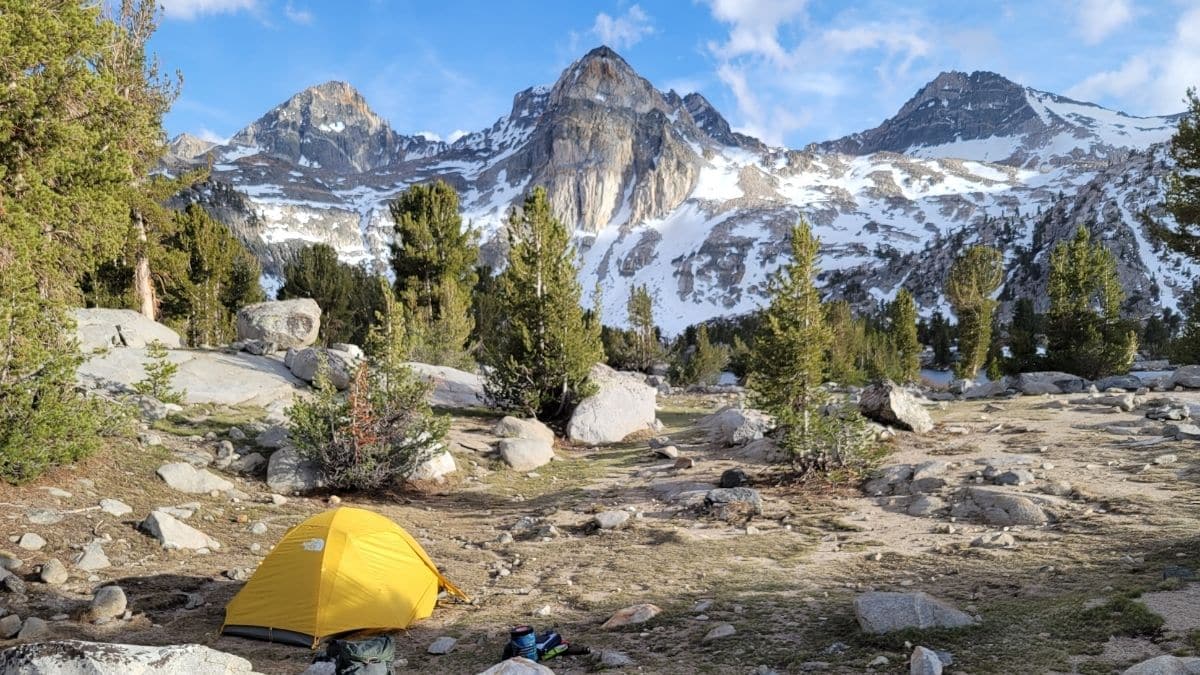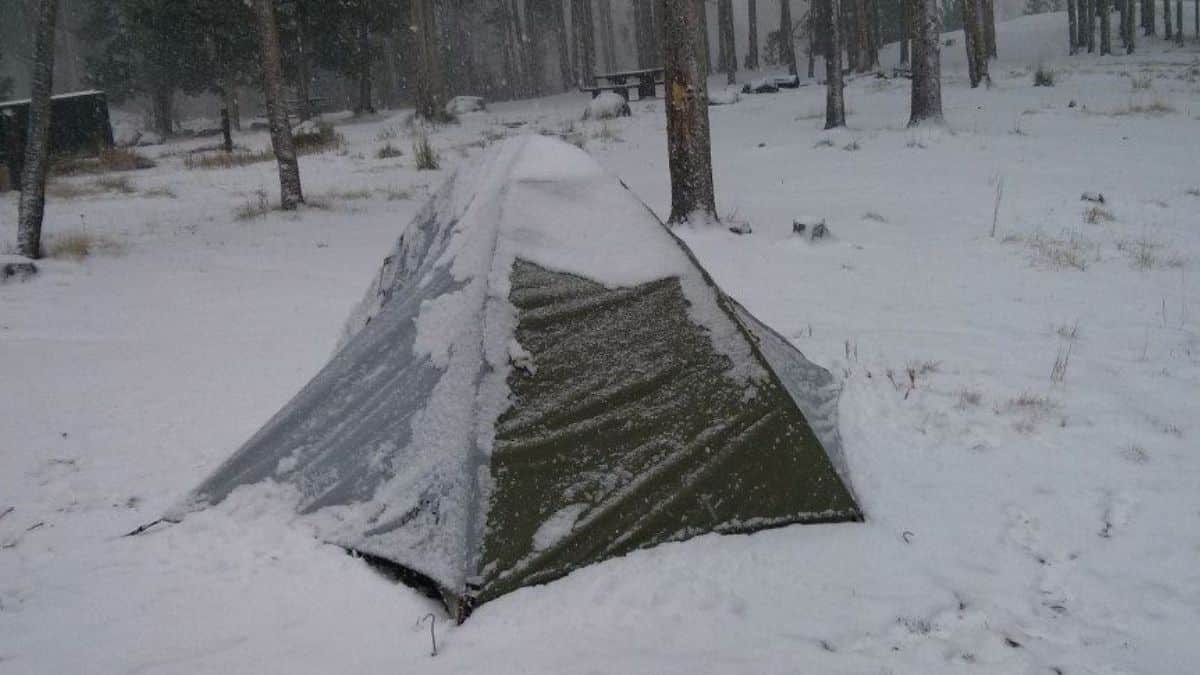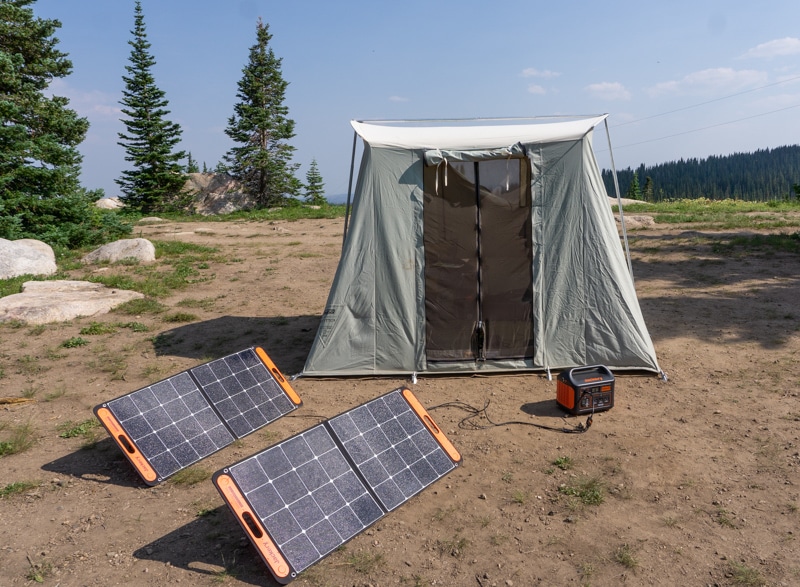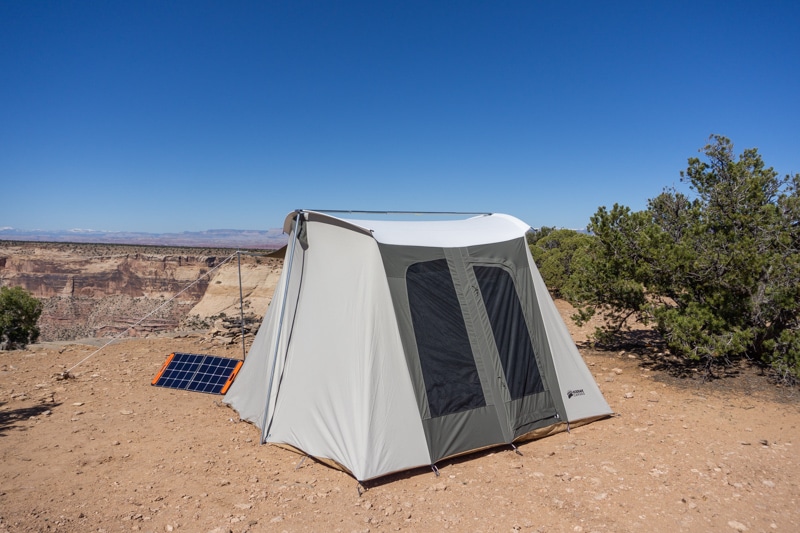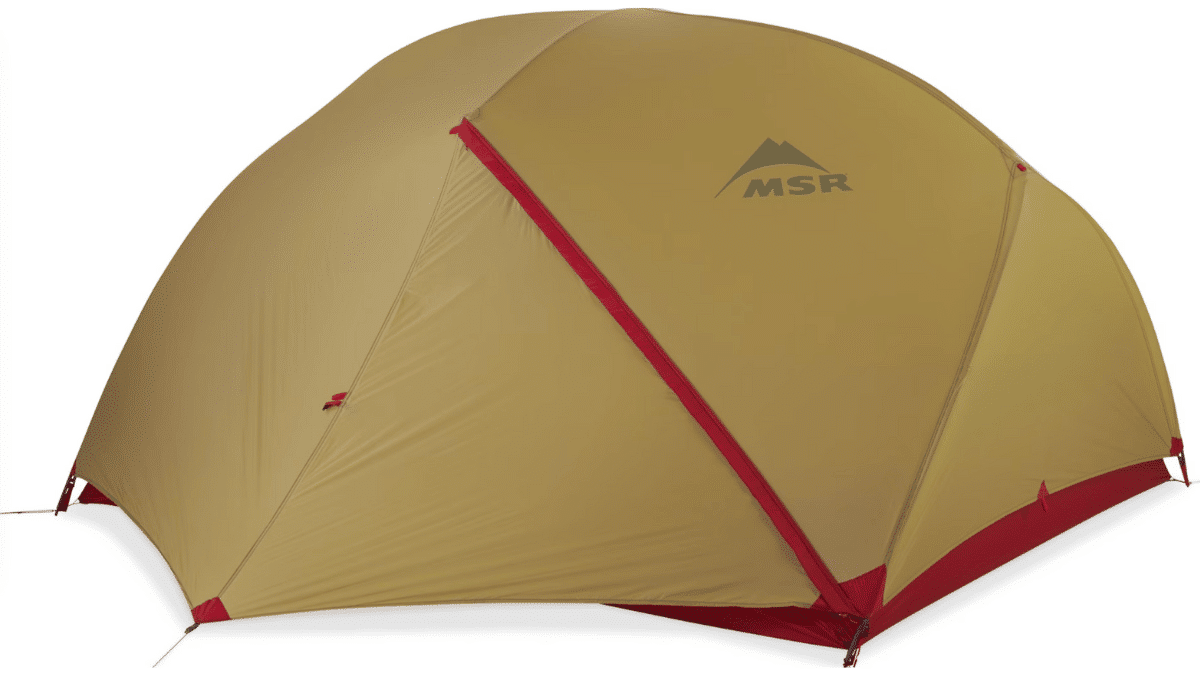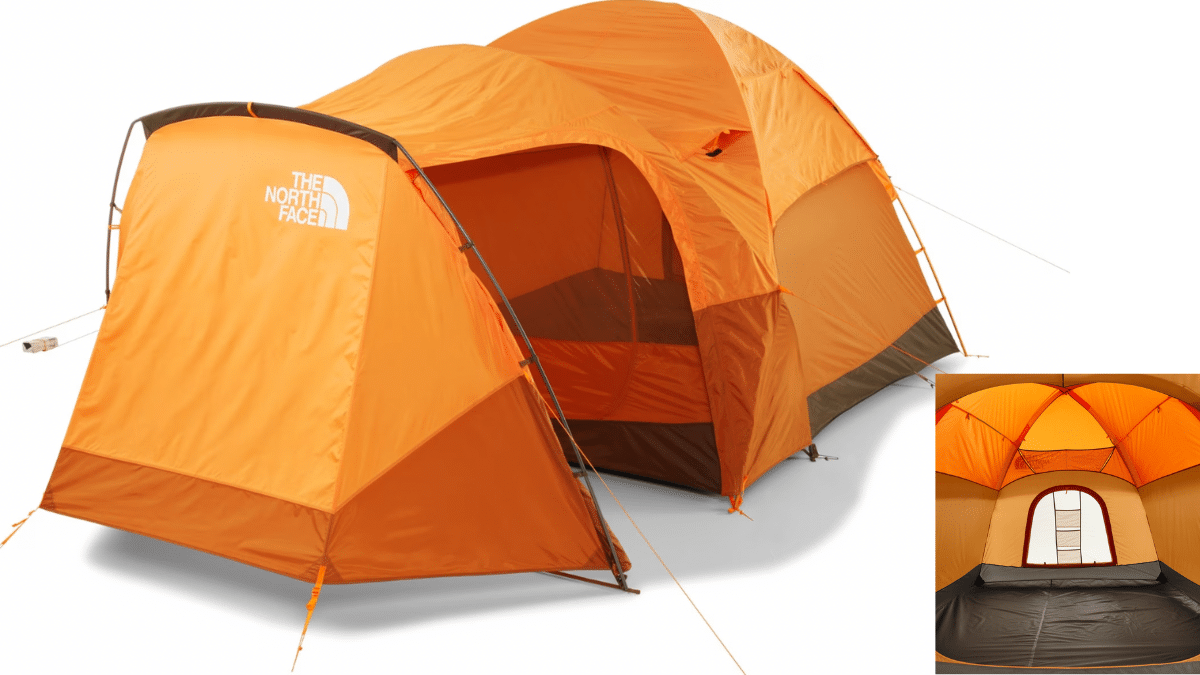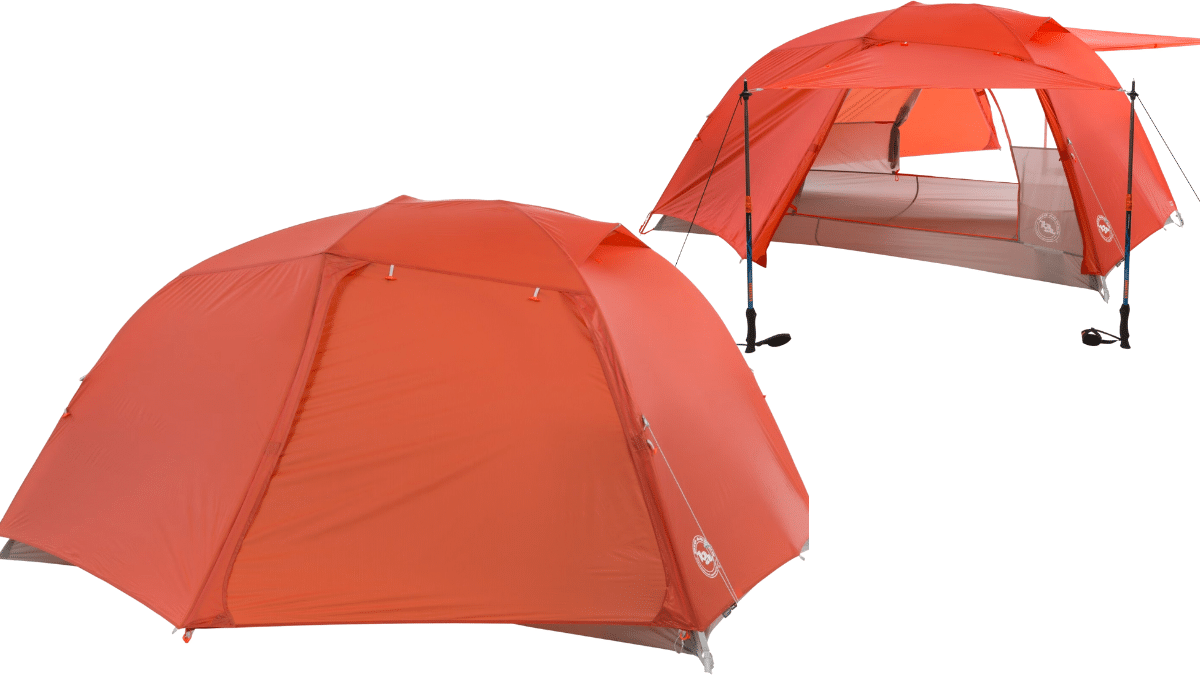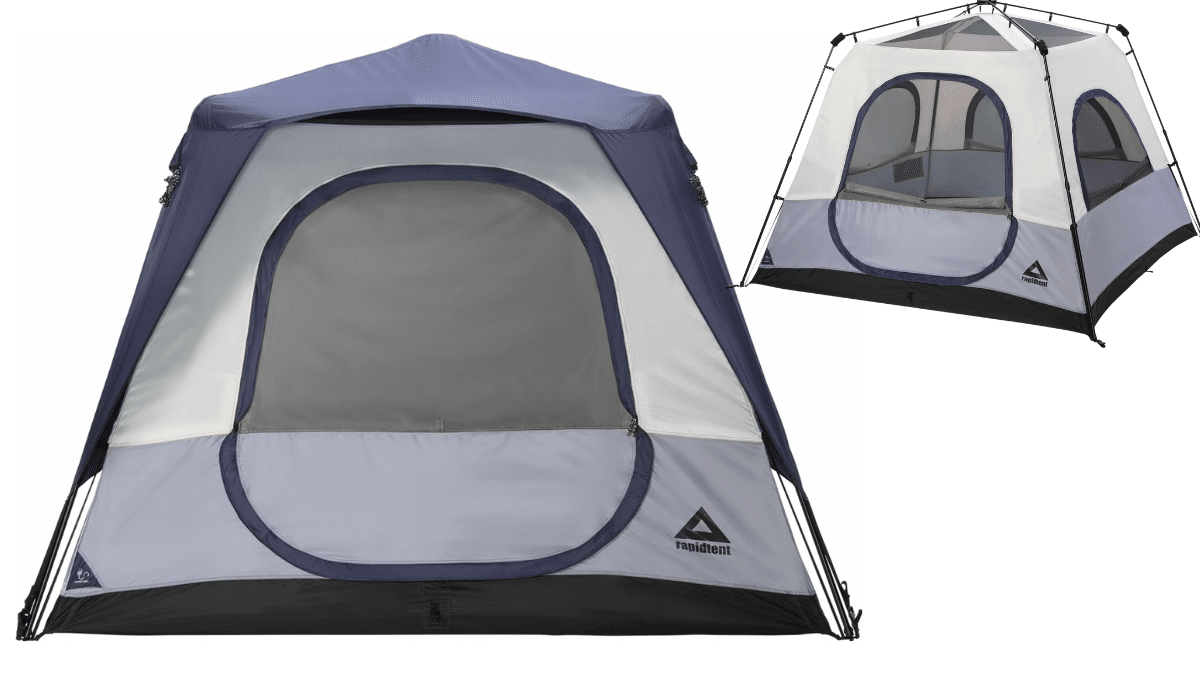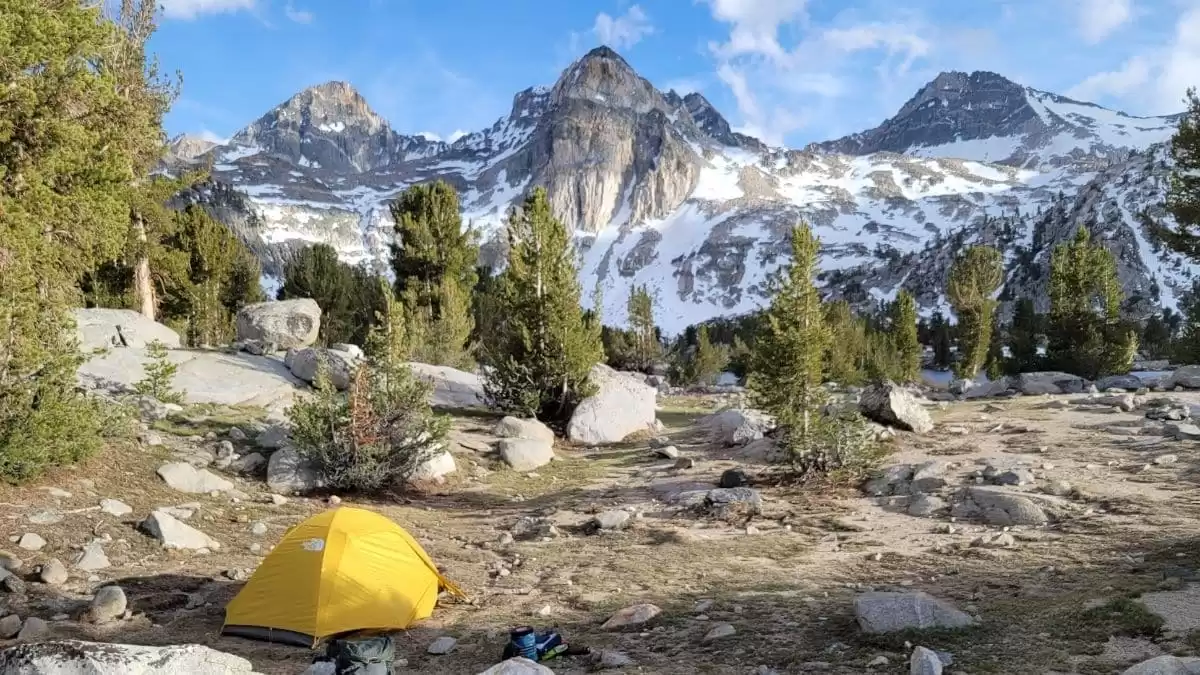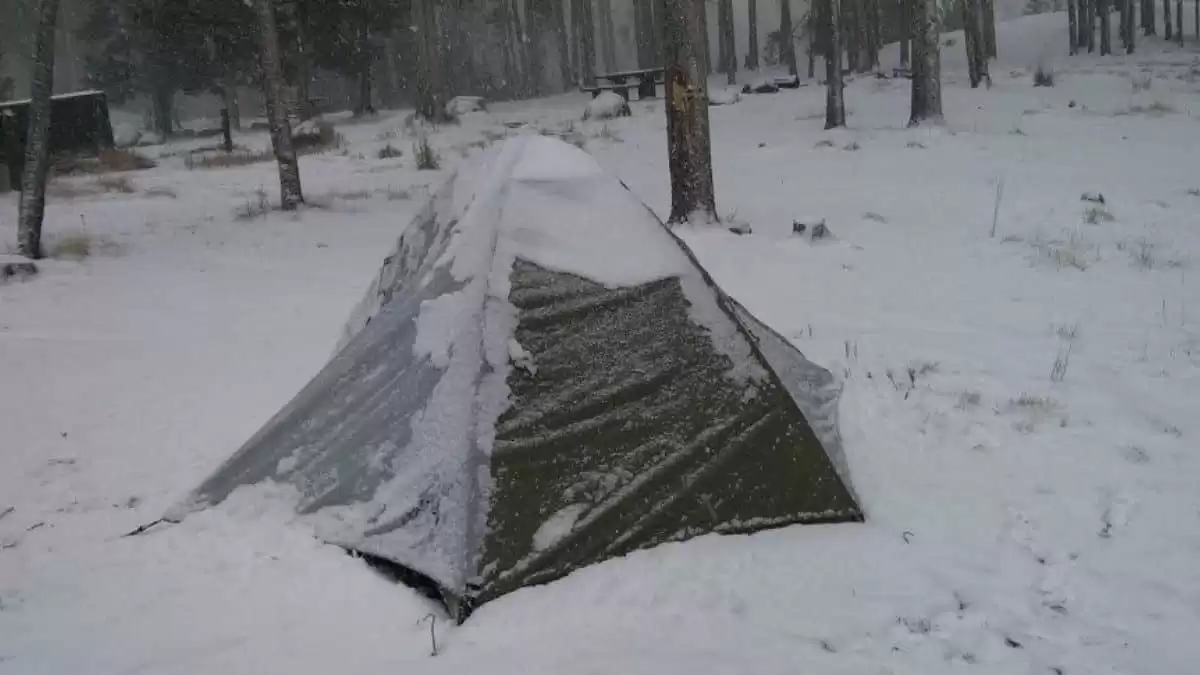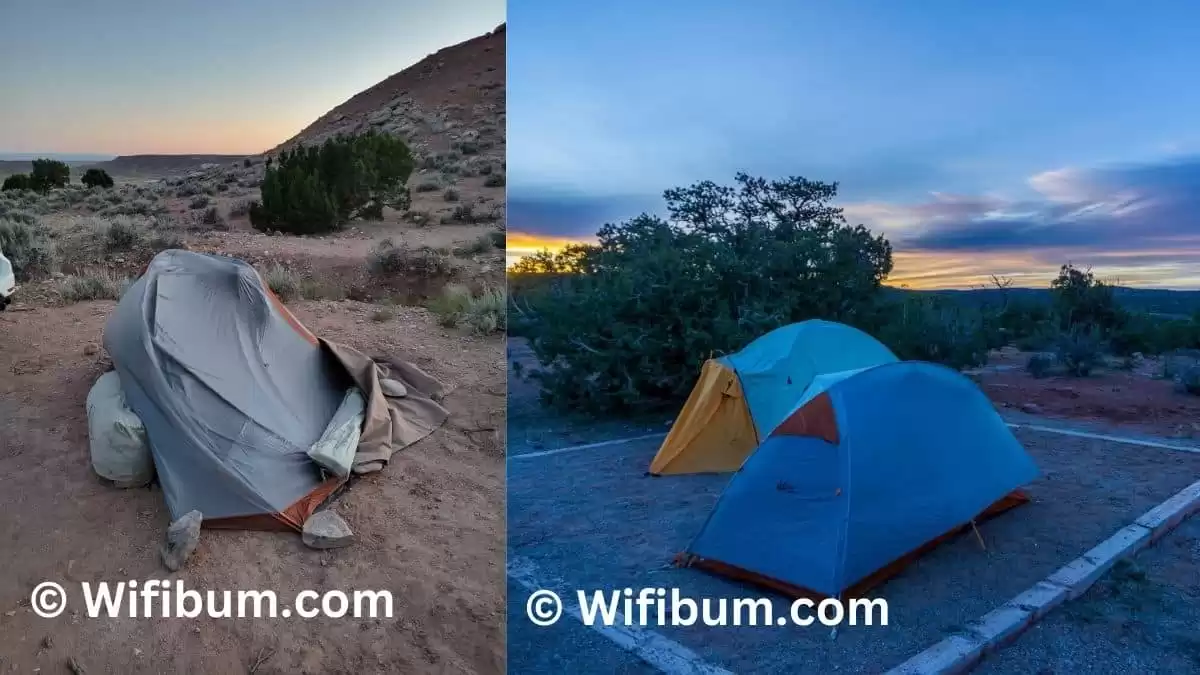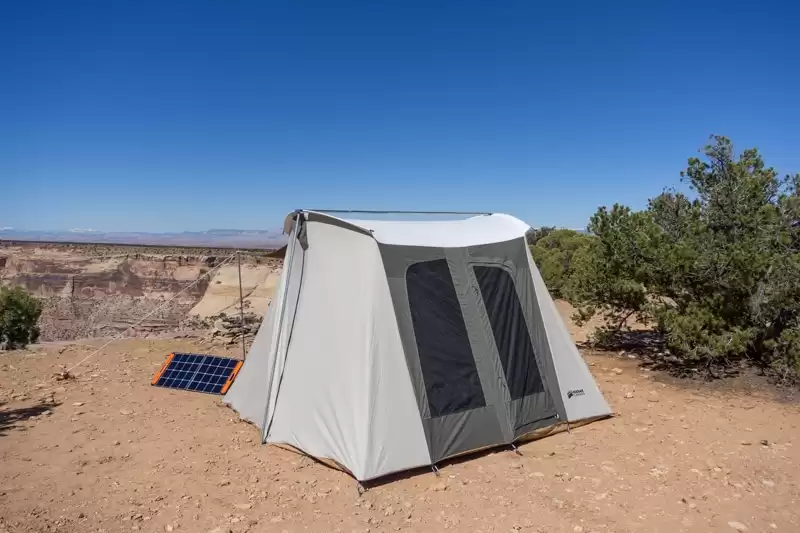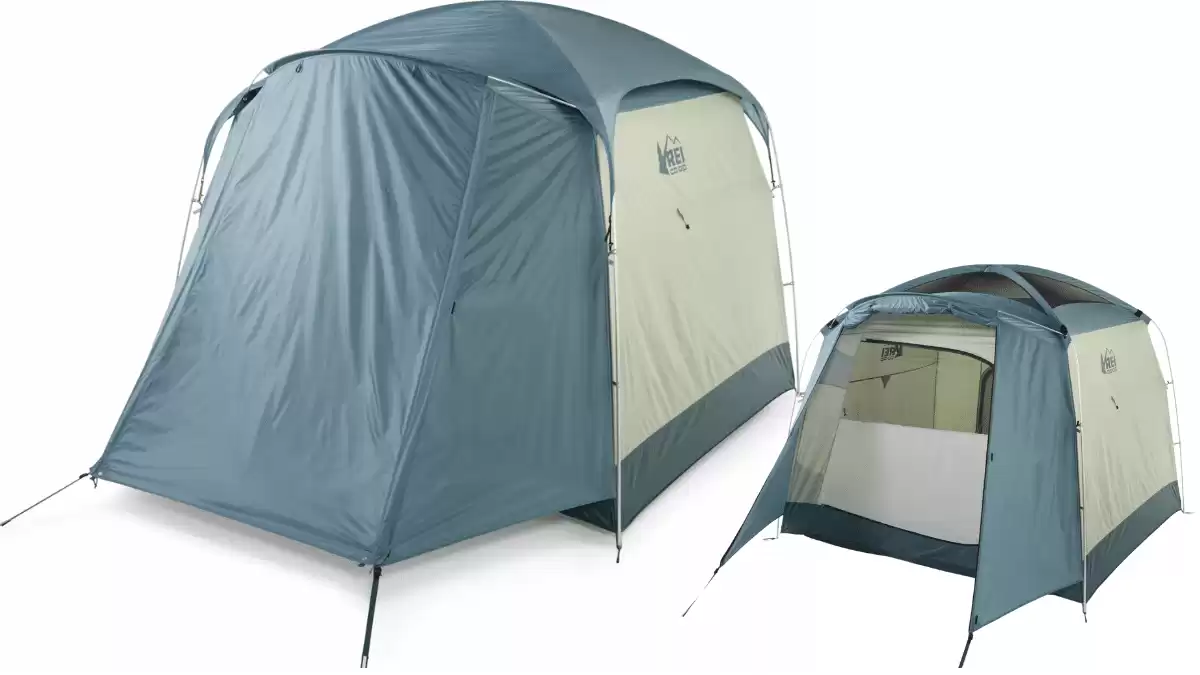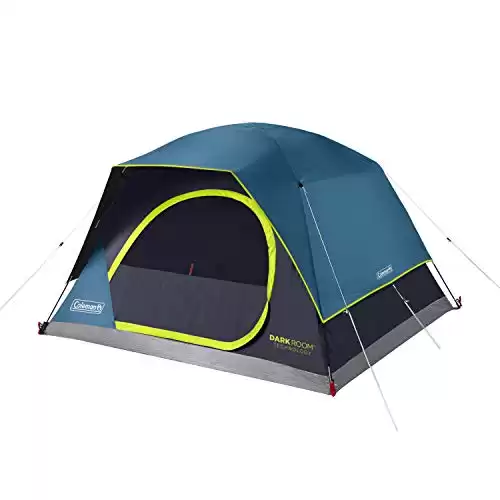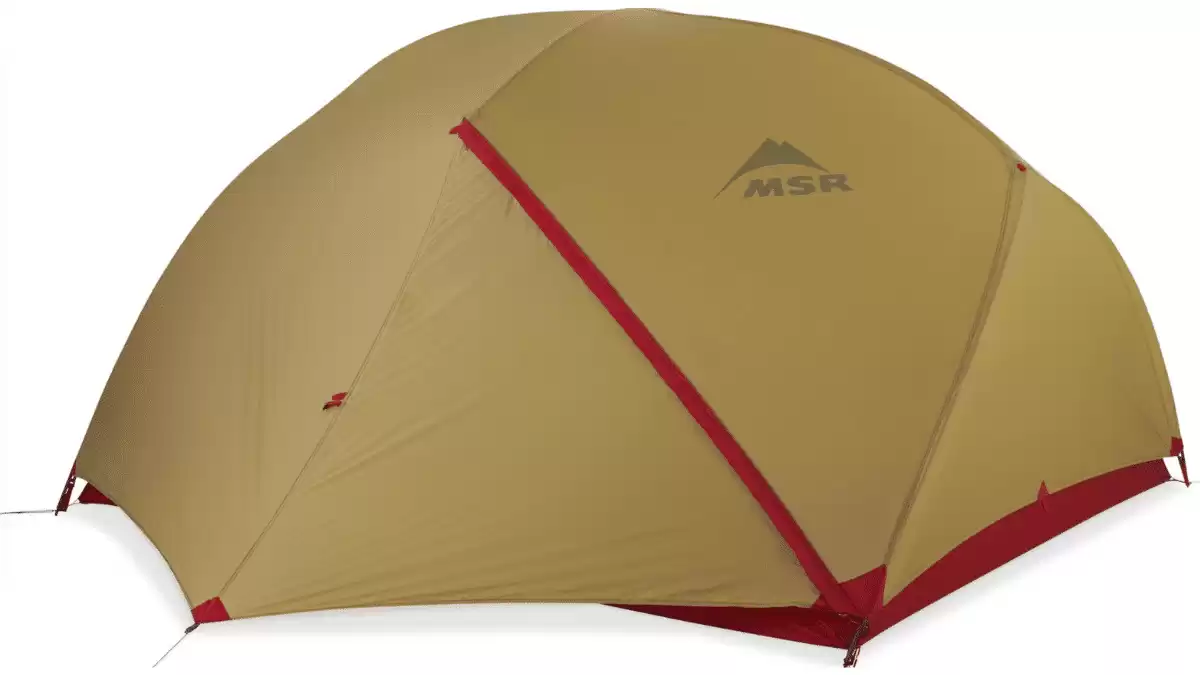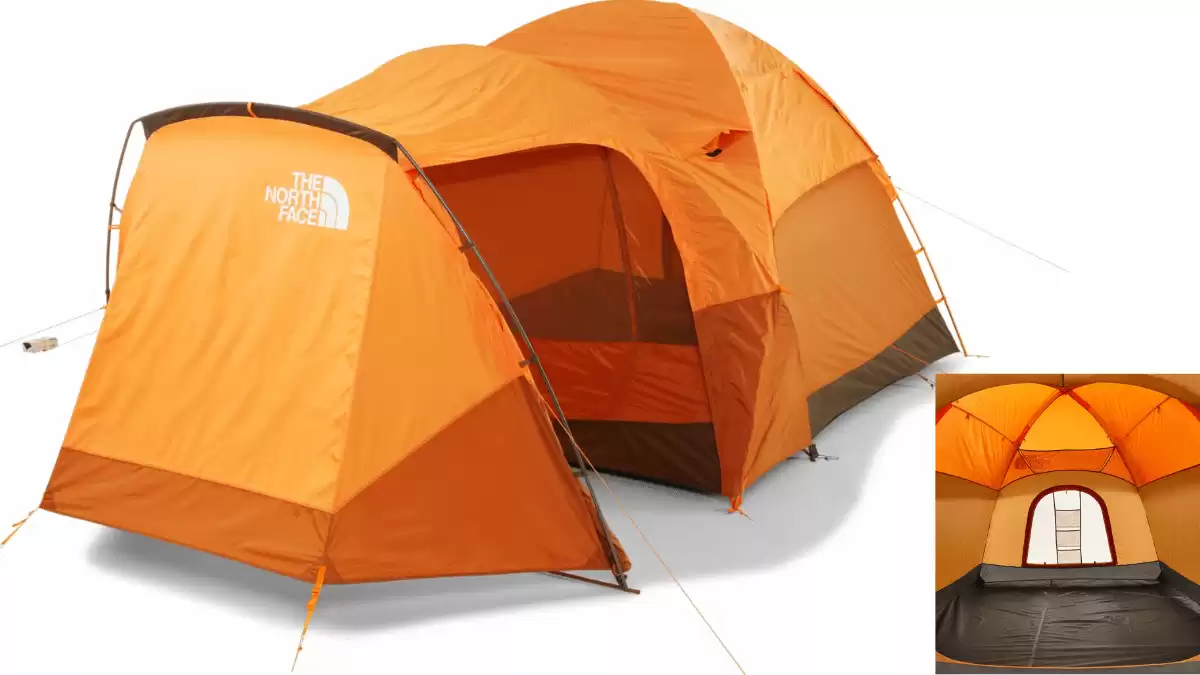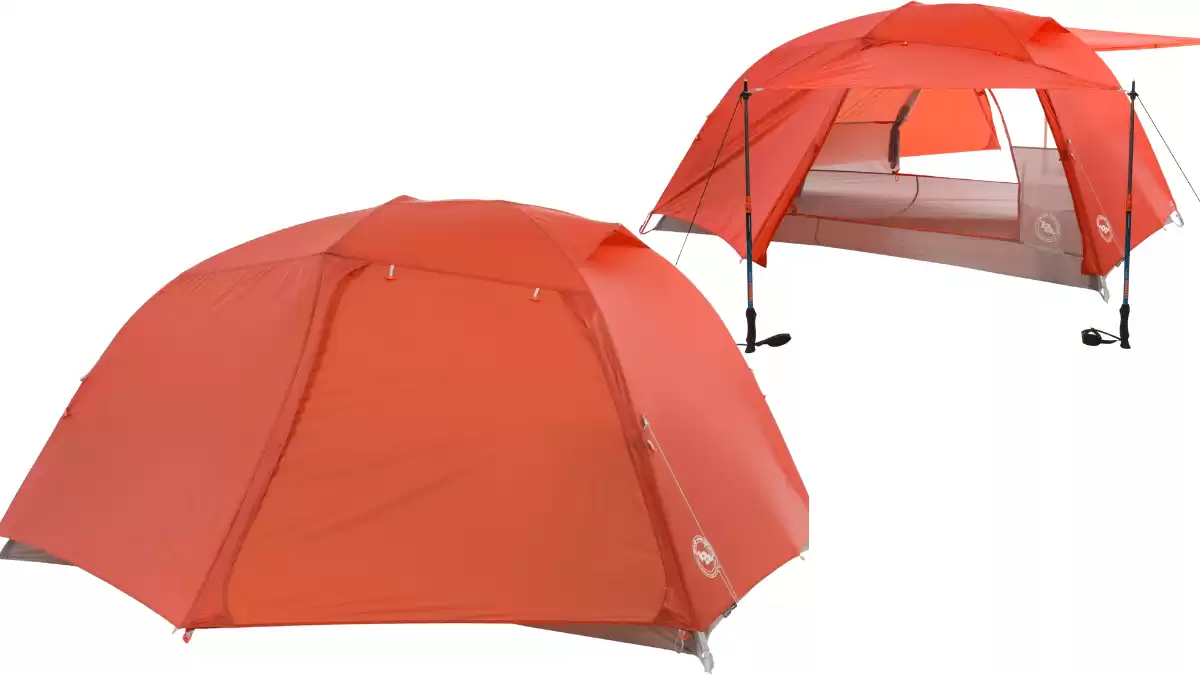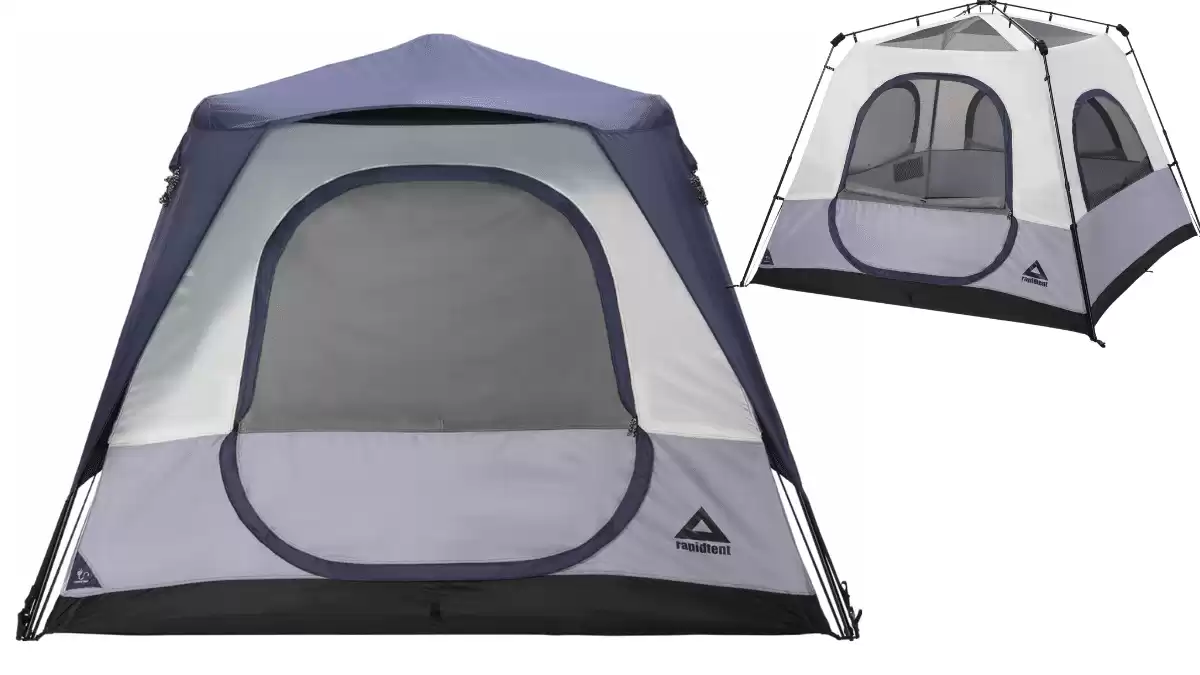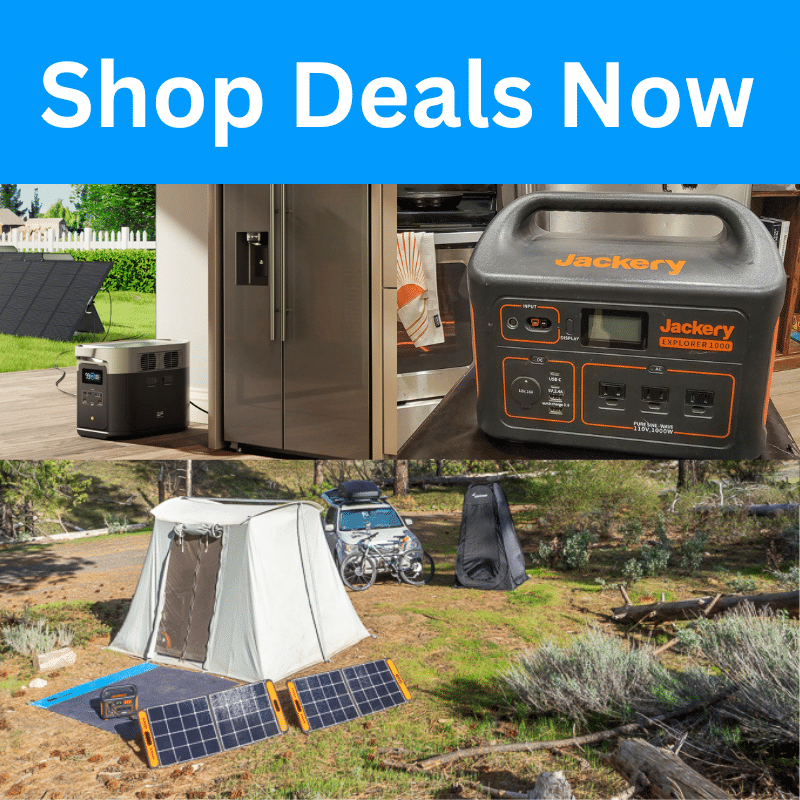Outdoor adventures often lead to camping in unpredictable weather. A waterproof tent is your protection from the elements and can make or break your camping experience.
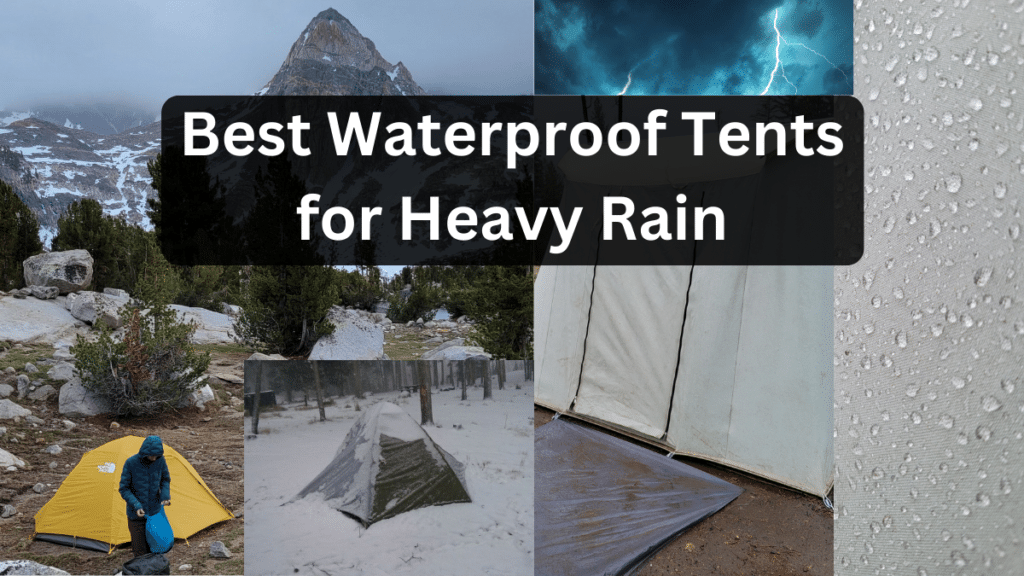
I’ve reviewed the best waterproof tents from hands-on experience, expert reviews, and reader submissions to compile the top 10 waterproof tents. From lightweight backpacking tents to family fortresses, these tents are the ones you want in any storm.
My top waterproof tents (jump to section)
- North Face Stormbreak 2
- Mountain Hardwear Meridian
- REI Trail Hut
- Springbar & Kodiak Canvas
- REI Skyward
- Coleman Skydome 4
- MSR Hubba Hubba
- The North Face Wawona 6
- Big Agnes Copper Spur
- Caddis Rapid 4 Tent
Buyers Guide: Choosing the Best Waterproof Tent
How Tents are Tested for Waterproofness
Best Waterproof Tents for Keeping You Dry
A tent that is waterproof and reliable is key to backpacking and car camping. Here are my favorites that I’ve tested myself.
1. The North Face Stormbreak 2 Tent
The North Face Stormbreak 2 is my favorite tent. I've had it for over 5 years and trust it to handle the most severe weather.
- Extremely reliable
- Budget-friendly (for backpacking tents)
- Easy and Fast Setup
- Not ultralight
The North Face Stormbreak is my favorite tent for backpacking in harsh conditions. It’s been through many rain storms and I can verify it’s indeed waterproof.
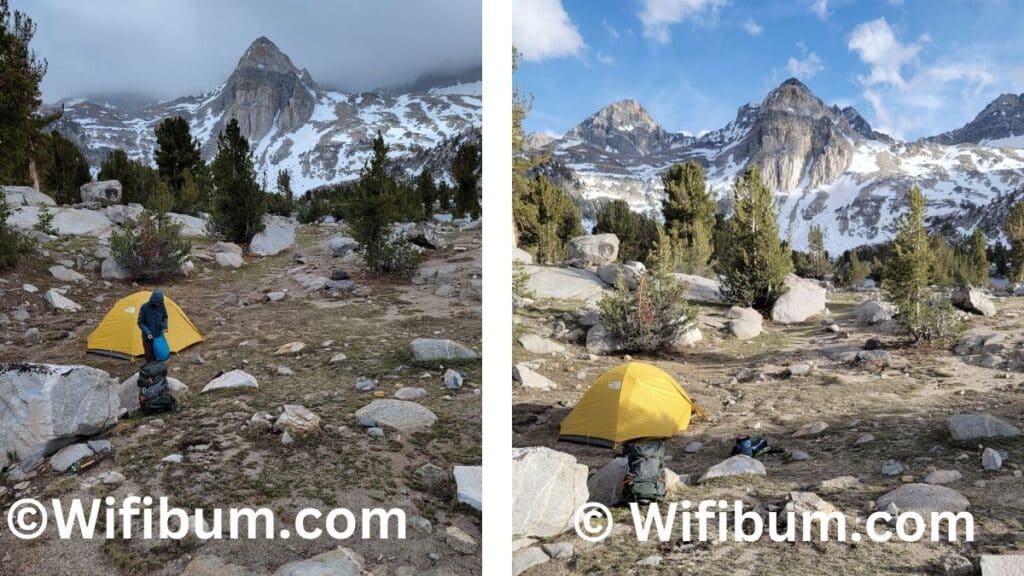
In the above photo, you can see how fast mountain weather can change. When you’re in the backcountry, you need a trustworthy and weatherproof tent.
Technical Specs:
| Best Use | Backpacking |
| Seasons | 3-season |
| Sleeping Capacity | 2-person |
| Packaged Weight | 5 lbs. 14 oz. |
| Packed Size | 7 x 22 inches |
| Floor Dimensions | 87 x 50 inches |
| Vestibule Area | 9.78 + 9.78 square feet |
| Peak Height | 43 inches |
| Number of Doors | 2 doors |
| Floor Fabric | 68-denier polyester with 3,000 mm polyurethane coating |
| Rainfly Fabric | 75-denier polyester with 1,200 mm polyurethane coating |
While it won’t impress the lightweight community, it is easy to set up, reliable, and handles intense wind and rain. It’s also affordable at under $200.
I’ve had this tent for 5+ years. This year, I had to replace the shock cord in the tent poles, but that is normal as tents age. I love that it’s easy to set up and the guy lines are simple to stake out properly, ensuring water sheds away from the tent.
2. Mountain Hardwear Meridian 2 (or 3)
My girlfriend has owned the Mountain Hardwear Drifter 2 (now the Meridian) for over 10 years.
When I asked her if it should be included in this list of best waterproof tents, she responded “YES!”.
Ms. WifiBum's favorite backpacking tent for all weather including rain. It's kept her bone dry and has proved to be waterproof over years of use.
- Waterproof - can handle days of rain
- Easy setup
- Reliable
- Affordable
- Not ultralight
- Could be too small for 2 larger folks
It’s been her favorite tent for years. She said she swears by it after being in a storm for consecutive days while she was doing the Corsica GR20. It kept her dry, and she was able to finish the trek. For those unaware, it is a 110-mile north-south across the island of Corsica (she’s a badass).
She used it from the mountains of New Hampshire to the Wind River Range.
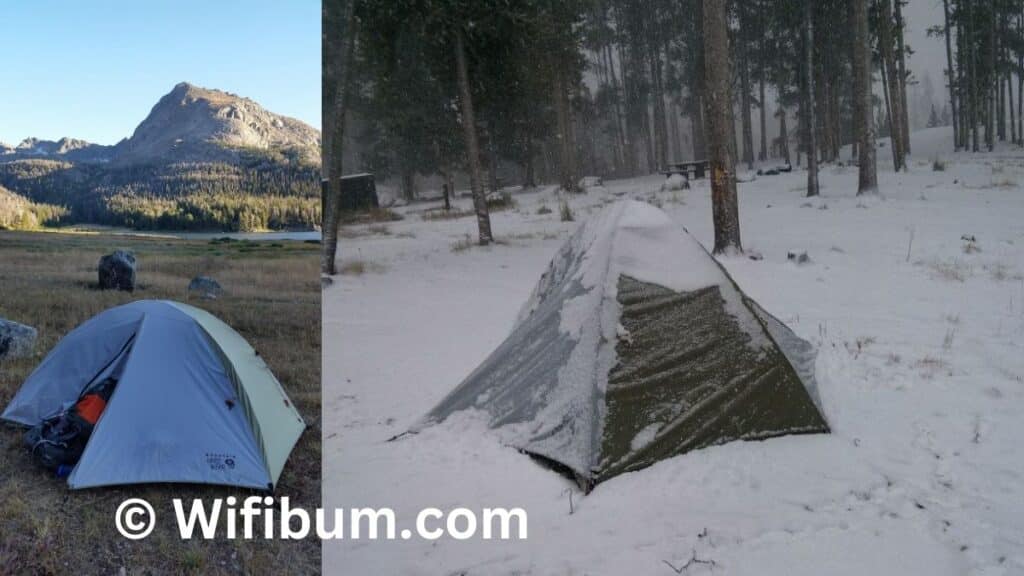
Technical Specs:
| Best Use | Backpacking |
| Seasons | 3-season |
| Sleeping Capacity | 2-person |
| Packaged Weight | 5 lbs. 8.6 oz. |
| Packed Size | 7 x 22 inches |
| Floor Dimensions | 88 x 52 inches |
| Vestibule Area | 9.85 + 9.85 square feet |
| Peak Height | 43 inches |
| Number of Doors | 2 doors |
| Pole Material | High-grade aluminum |
| Pole Diameter | 9 millimeters |
| Floor Fabric | Nylon; 68-denier 210T ripstop polyester; 1,500 mm PU coating |
| Rainfly Fabric | Polyester; 68-denier 210T ripstop polyester; 1,500 mm PU coating |
It’s her favorite 3-season backpacking tent and she trusts it in the harshest of conditions.
3. REI Trail Hut: Best Budget Waterproof Tent
REI branded tents are the best backpacking tents for those on a budget. They are private labeled which means no middleman.
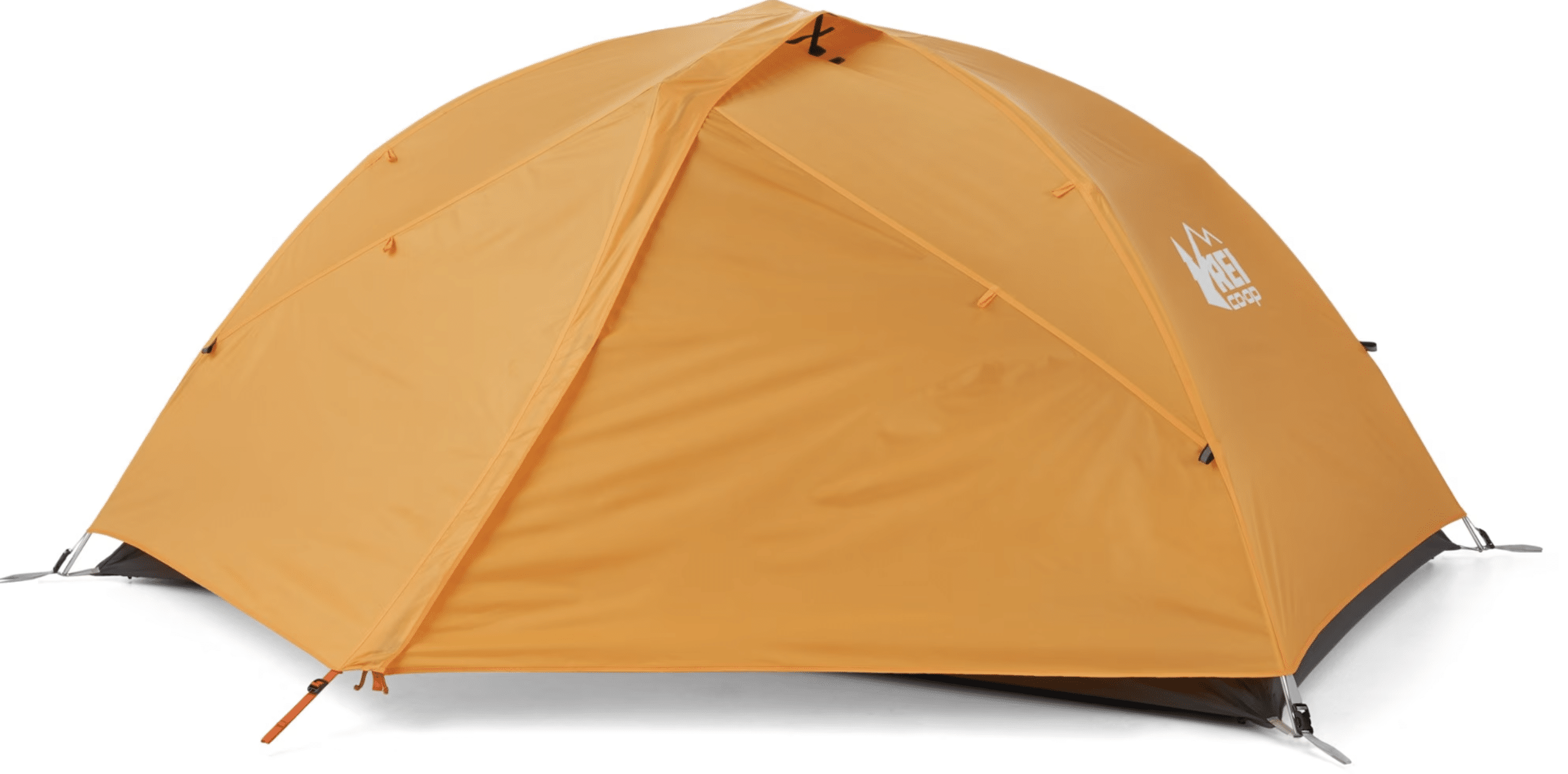 REI Co-op Trail Hut 2 Tent with Footprint
REI Co-op Trail Hut 2 Tent with Footprint REI-branded tents like the Trail Hut series provide decent tents at affordable prices. I trust it backpacking in the mountains, but if there was severe storm potential, I might be hesitant to bring it.
For most people, this will do just fine.
- One or two person option
- Good quality for the price
- Reliable, but probably wouldn't trust it in the most severe rain storms
- Material started sticking together easily after about 5 years
- Shock cord needed to be replaced within 2 years
- Not ultralight
This is my REI quarter dome 1 that I still rock today. Now, the closest thing to it is the REI Trail Hut 1. The picture on the left is 50+mph winds in Vernal, UT. That night, it rained with the wind, and I somehow stayed dry. Completely waterproof during intense storms.
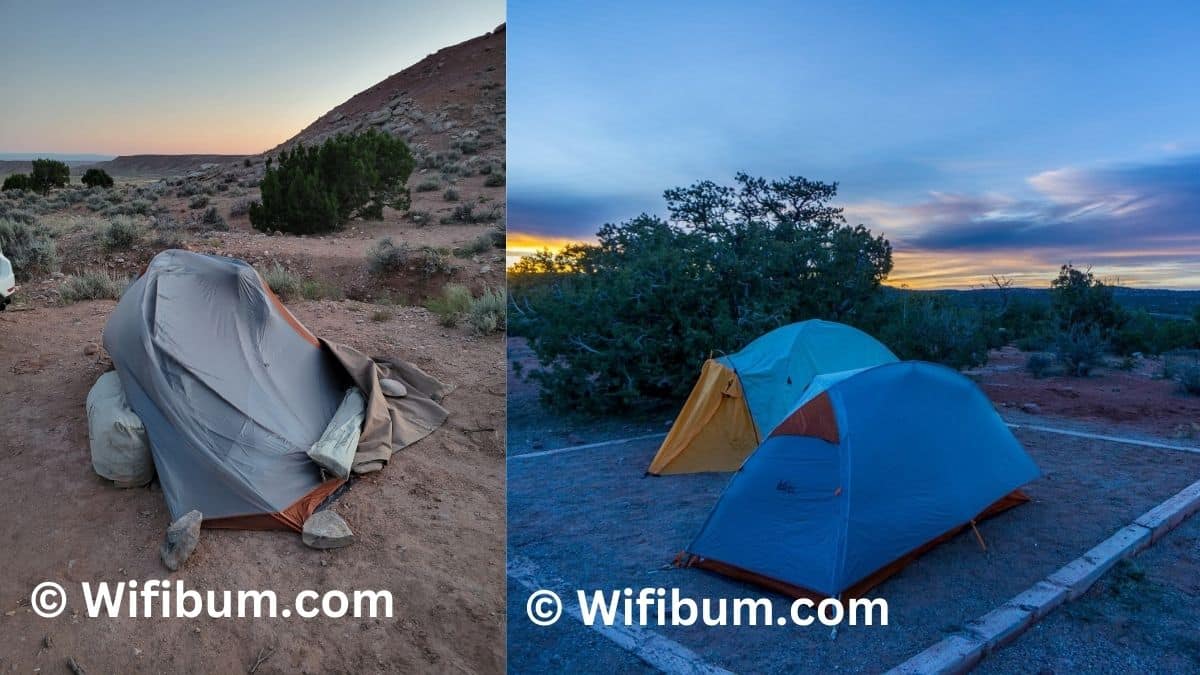
| Best Use | Backpacking |
| Seasons | 3-season |
| Sleeping Capacity | 2-person |
| Packaged Weight | 5 lbs. 15 oz. |
| Packed Size | 8 x 18 inches |
| Floor Dimensions | 88 x 52 inches |
| Vestibule Area | 19 square feet |
| Peak Height | 40 inches |
| Number of Doors | 2 doors |
| Pole Material | Aluminum |
| Pole Diameter | 8.5 millimeters |
| Floor Fabric | Polyester |
| Rainfly Fabric | Coated nylon taffeta |
However, after 5+ years it is showing its wear. The material sticks together easily, the shock cords in the tent poles wore out way faster than any other tent I’ve owned. However, with proper care and some minor maintenance, their brand is surprisingly good for the price.
4. Canvas Tents: Springbar and Kodiak Canvas (4 to 8 person waterproof tent)
If you’re looking for a 3-season+ heavy-duty tent, consider a canvas tent.
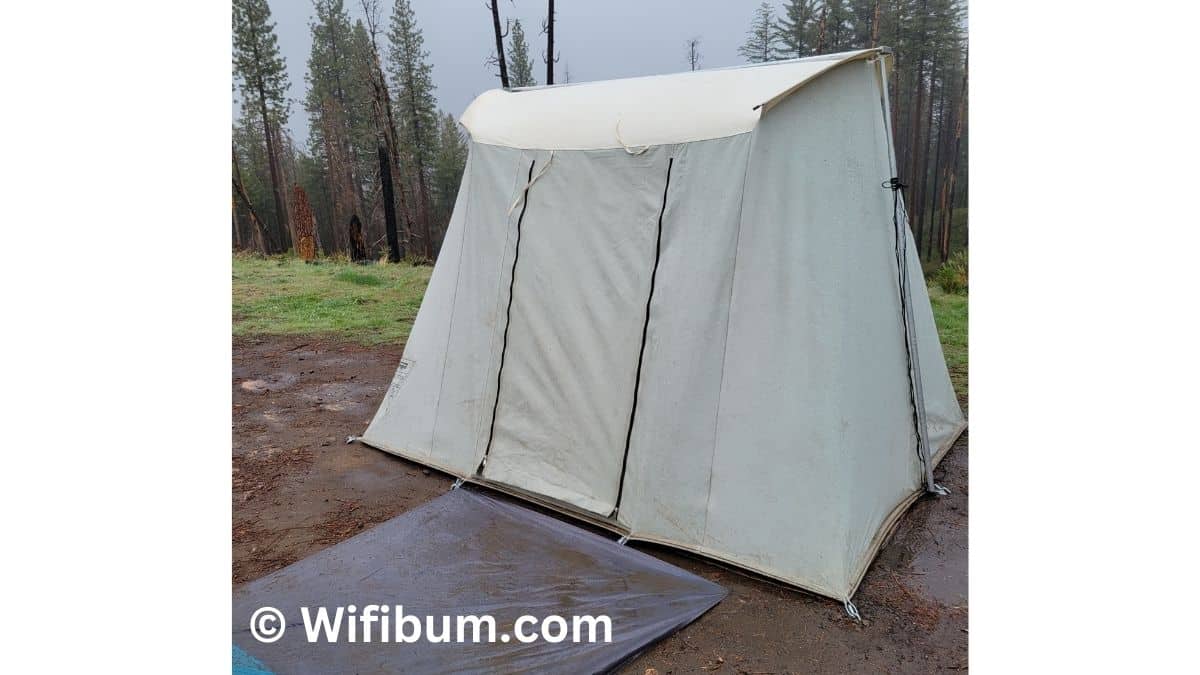
They are durable, reliable, and handle wind and rain like it’s nothing. They don’t even need a rainfly. The canvas is treated and waterproof, without a rainfly!
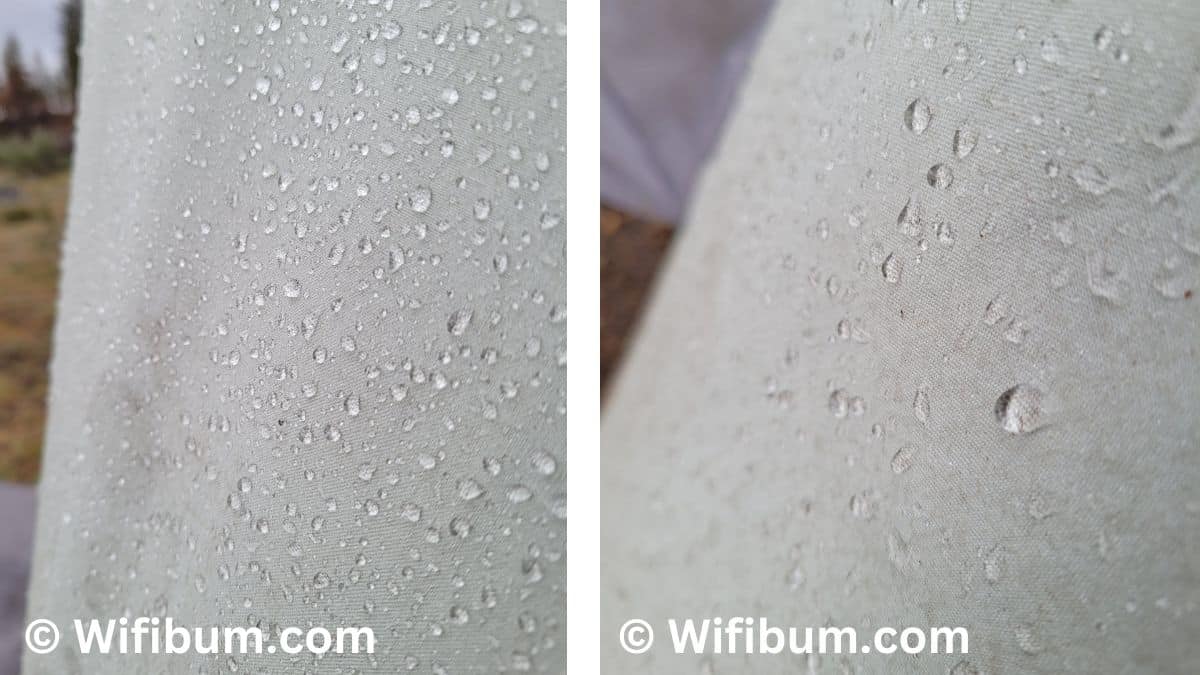
Water beads on the canvas, and while the material will soak, the fibers are woven so tight they don’t let water in. They are old school, but they are still very popular, especially for families.
I can attest to their waterproofing. I spent months living out both a Springbar and Kodiak canvas tent.
A cheaper alternative to Springbar is Kodiak. You can read my full Kodiak Canvas review here.
Pros
- Durable – canvas tents have been used for years, from family camping to mountain base camps.
- Waterproof – canvas is naturally water repellent, but most will be treated making them extremely reliable in the rain, even without a rain fly.
- Breathable – canvas tents are naturally breathable. Learn more about the benefits of canvas tents vs nylon and polyester.
- No guy lines or rain fly required
Here’s a video I put together showing how water beads up on the tent. It stormed all night and I was completely dry.
Cons
- Heavy! – They range from 50 to 100+lbs depending on the size. Thankfully, you can separate the poles, canvas, and stakes to make it manageable.
- Inconvenient to dry out – drying out requires setting it up outside or a large garage.
The Kodiak 10x10 is perfect for families and is considered a 6 person tent.
To learn more about canvas tents, read my best canvas tents article.
5. REI Co-op Skyward 4 Tent
Staying with the REI-branded tents, the Skyward 4, also available as a 6-person, has become their starter tent for family camping.
Why would you choose this over the cheaper alternatives like Coleman?
Simple.
The REI return policy is the best in the business. If you have it in a storm and it doesn’t work, then you can simply return it even after using it several times.
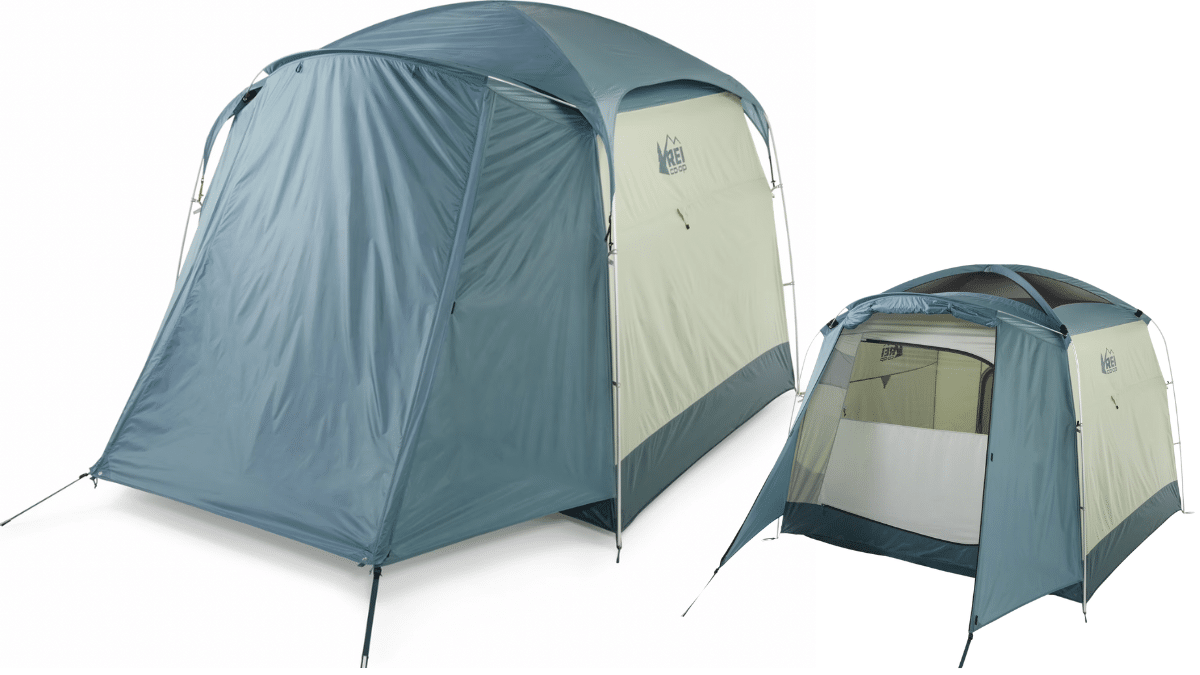 REI Co-op Skyward 4 Tent
REI Co-op Skyward 4 Tent The REI Skyward 4 (or 6) is a great starter tent for getting into camping. It's easy to set up, spacious and will keep the water out.
Best of all, it's extremely affordable.
However, this is not a tent you want to be in during severe storms.
- D-Shape door makes getting gear in and out easy
- Vented ceiling
- Awning
- Tall ceilings
- Not a tent you want in high winds
Technical Specs:
| Best Use | General Camping |
| Seasons | 3-season |
| Sleeping Capacity | 4-person |
| Packaged Weight | 13 lbs. 11 oz. |
| Packed Size | 9.8 x 27.5 inches |
| Floor Dimensions | 100 x 86 inches |
| Vestibule Area | 19.5 square feet |
| Peak Height | 78 inches |
| Number of Doors | 1 door |
| Pole Material | Aluminum |
| Floor Fabric | 150-denier coated polyester |
| Rainfly Fabric | 75-denier coated polyester |
6. Coleman Skydome 4: Best Budget-Friendly Option
If you’re the occasional weekend warrior family camper, a budget tent like the Coleman Skydome 4, 6, 8, or 10 is a great option.
This tent will be fine in normal rain and mild to moderate storms. However, the frame withstands up to 35mphs, which means you’re in trouble in windy areas. Rain will soak the fabric and make it the material heavier, so if you expect winds above 25mph and wind, I would consider staying home.
 Coleman Skydome 4 Budget Tent
Coleman Skydome 4 Budget Tent The Coleman Skyline is available as a 4-person, 6-person, 8-person, and 10-person tent.
It's great for those that are fair-weather campers with the occasional rain shower.
I would not recommend in harsh environments.
- Quick Setup: Less than 5 minutes
- Spacious
- Affordable
- Not as durable as other options
- Some reports of leaks
Technical Specs:
| Best Use | General Camping |
| Seasons | 3-season |
| Sleeping Capacity | 4-person |
| Packaged Weight | 11 lbs. 0 oz. |
| Packed Size | 8.75 x 24.5 x5.25 inches |
| Floor Dimensions | 56 square feet |
| Peak Height | 84 inches |
| Number of Doors | 1 door |
Otherwise, this tent will be great most of the year. If you’re camping rain or shine, you might want to upgrade.
7. MSR Hubba Hubba 3 Tent: Lightweight and Waterproof Tent
The Hubba Hubba 3 Tent makes a lot of waterproof tent lists. The setup looks very similar to the North Face Stormbreaker 2, so it makes sense that it is highly rated in terms of setup and holding out the rain.
The MSR Hubba Hubba 3 is for those looking to go ultralight.
For comparison, the MSR Hubba Hubba 3 is 3lbs 7oz vs the North Face Stormbreak 2 at 5 lbs 14 oz. Not only is it larger, it's 2lbs lighter!
- Lightweight
- Good reviews on REI
- Price
- Durability concerns (thinner than other options) in harsh conditions
While it’s a 3-person tent, most use it as a 2-person (or plus a child). It’s a great 2-person tent for larger people (tall or wide).
Why does it cost so much? Even though it’s noticeably bigger than the Stormbreaker 2, it is 2lbs less in weight.
Technical Specs:
| Best Use | Backpacking |
| Seasons | 3-season |
| Sleeping Capacity | 3-person |
| Packaged Weight | 3 lbs. 13 oz. |
| Packed Size | 5 x 20 inches |
| Floor Dimensions | 84 x 68 inches |
| Vestibule Area | 15 square feet |
| Peak Height | 46 inches |
| Number of Doors | 2 doors |
| Pole Material | Easton Syclone |
| Floor Fabric | 20-denier ripstop nylon with a 1,200 mm Durashield coating |
| Rainfly Fabric | 20-denier ripstop nylon with a 1,200 mm DuraShield coating |
The MRS Hubba Hubba uses lightweight materials making it more costly than the average tent. The walls and rainfly about 1/3 as thick as a “standard” backpacking tent meaning it will be a bit more fragile.
Other Options to Consider
I like to focus my articles on hands-on, personal experience. However, it’s impossible to test and try every tent on the market.
Based on my research, here are some other tents to consider when keeping water out is of primary concern:
8. The North Face Wawona 6
The North Face Wawona is a great all-weather tent for families that value space and durability. It’s a 6-person tent with a huge vestibule making it feel larger.
Outdoor GearLab has a great review on it. Check it out here.
The color-coded poles make setup simple and the large vestibule is great for storing gear during a storm.
9. Big Agnes Copper Spur UL2
Switchback Travel has a great review showing the intricacies of the tent.
10. Caddis Rapid 4 Tent
I searched REI for reviews that mention “rain” and are 4 or 5 star and the Caddis Rapid 4 had plenty. Read the waterproof reviews here.
It’s a quick setup tent, and it’s thick tent material and rainfly seem to do a great job at keeping it waterproof.
Buyers Guide: Choosing the Right Waterproof Tent for You
Selecting the perfect waterproof tent involves more than just finding a shelter that keeps the rain out. It’s about balancing various factors to ensure that your outdoor experience is as comfortable and hassle-free as possible.
Here’s what you need to consider:
Which Waterproof Tent is Right for You?
Great waterproof tents are available at any size and weight. Are you going to be adventuring into the backcountry where a tent is a primary piece of eqiupment that will keep you safe? Or are you car camping where weight and durability are less important?
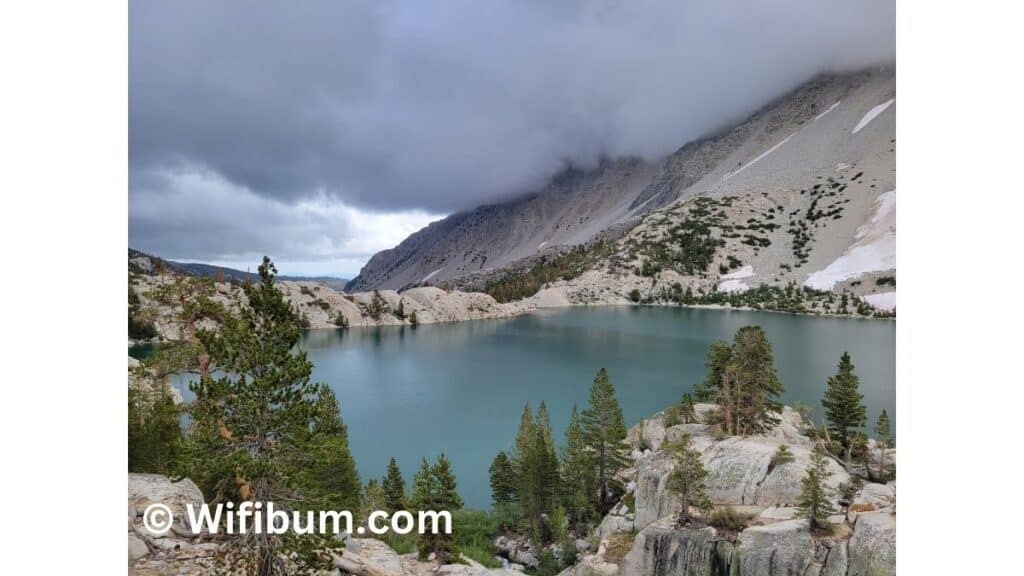
For example, if your tent doesn’t hold up in a storm, worst-case scenario is you spend the night in your vehicle.
How Often You Backpack and Camp
If you’re a camping once or twice a summer, stick with the budget-friendly options. Most tents will be waterproof with proper setup. However, if you go TOO cheap, there’s no guarantee it will hold up.
That’s why I recommend at least sticking with Coleman or better. Anyone can import things to Amazon site unseen and list it under some random brand name. Avoid those and you should be fine.
For those that are active backpackers, you’re going to want a reputable brand. Once you’re in the mountains, your tent is a primary factor in keeping you safe. It’s an essential piece of gear that needs to work in harsh weather and keep you dry.
Stick with reputable brands like North Face, Mountain Hardwear, and MSR.
Canopy, Floor, and Rainfly Fabric
Most tents will list their floor, canopy, and rainfly denier. In general, the higher the number, the thicker or more rugged fabric (source).
Your tent fabric is your first line of defense, so understanding denier is imporant.
Picture the canopy as the tent’s skin, the rainfly as its shield against the storm, and the floor as the foundation—each component needs to be robust enough to handle whatever comes its way.
When you’re comparing tents, a canopy with a higher denier will withstand more abrasion, a beefier rainfly will fend off piercing raindrops better, and a sturdier floor will resist tears from the rough ground beneath. Always check the denier to gauge the tent’s potential for durability and protection.
Weight
The weight of your tent varies in importance. If you’re backpacking, it’s a huge consideration. If you’re camping next to your car, it’s not a big deal.
The general rule is the lighter, the better, but not at the expense of durability and protection.
Ultralight tents are available for those willing to pay a premium for the best in lightweight materials, like carbon fiber poles and silicone-treated nylon fabrics. If you’re car camping, weight is less of a concern, but it’s still worth considering for the ease of transport and setup.
I love to car camp with my canvas tents that are super heavy, but extreme durability and tons of space.
Capacity
Capacity is not just about how many people can sleep inside the tent, but how comfortably. A ‘two-person’ label often doesn’t account for storage of gear, room to move, or extra space you might want for comfort. When in doubt, size up.
If you’re a family of four, consider a six-person tent to accommodate gear and provide extra room for activities inside the tent.
Seasonality
Tents are rated by the seasons they are designed to withstand. Three-season tents are the most common and are suitable for spring, summer, and fall. They’re built to endure downpours but might not stand up to heavy snowfall or extreme cold.
Four-season tents are designed for winter conditions and can handle snow loads and high winds. However, they are often heavier and less ventilated, which can be a drawback in warmer weather.
Consider a canvas tent with a wood-burning stove if you’re camping in late fall or winter.
Ease of Setup
Many tents are waterproofed only with proper rainfly setup. Simplicity is important. I love my North Face Stormbreak 2 because it’s simple to set up. Anyone could figure it out without instructions.
Instant tents with pre-attached poles are available for those who prioritize ease of setup above all else. However, in my experience, they tend to be less durable and heavier. Check user reviews for real-world setup times and consider doing a trial run at home before you head out.
Size and Comfort
Beyond the number of sleepers, consider the tent’s peak height if you want to stand up straight, and look for a tent with a footprint that fits your favorite campsite dimensions. Also, review the floor plan for adequate sleeping space and storage.
Consider tents with vestibules for gear storage or to keep your backpack and other gear dry.
Floor Plans and Ceiling Height
Floor plans are often overlooked, yet they’re fundamental to your comfort. A dome-style waterproof tent may offer more headroom in the center, while a cabin-style tent provides more consistent headroom throughout.
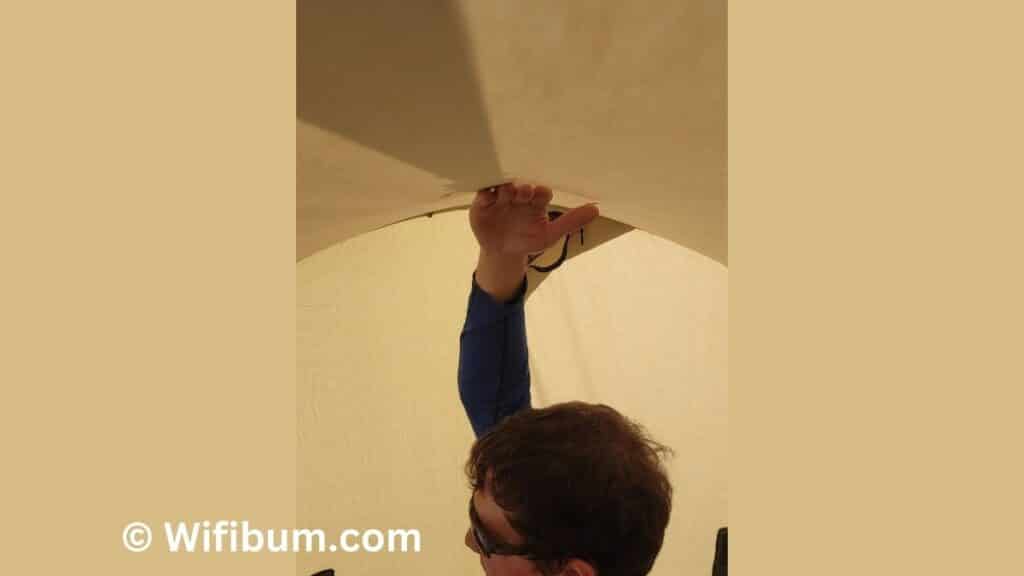
The above image is me (6 ft tall) showing how much headroom there is in a 10×10 canvas cabin tent.
Look for tents with near-vertical walls which maximize livable space. But there’s always a tradeoff. Those tents will not perform as well in harsh winds.
Having the additional ceiling height makes a tent feel less claustrophobic on rainy days where you’re playing cards or games all day.
Storage Options
A tent with pockets and loops can keep your small items organized. A gear loft is an excellent addition for keeping things off the floor.
Vestibules or awnings provide extra space outside the sleeping area for muddy boots and gear storage, keeping the interior clean.
Additional Considerations
- Ventilation: Proper airflow is crucial to prevent condensation. Look for tents with multiple vents or windows that can remain open during the rain.
- Waterproofing: A high hydrostatic head (HH) rating on the rainfly and tent floor indicates better waterproofing. Sealed seams and a full-coverage rainfly are must-haves.
- Material Durability: Higher-denier fabric canopies and rainflies resist wear and tear better but can add to the tent’s weight.
- Zippers: Quality zippers (YKK zippers) are a small but crucial feature. They should operate smoothly and be protected by a fabric flap for waterproofing.
- Repairability: Check if the tent comes with a repair kit. Being able to fix a tear or broken pole in the field can be a trip-saver.
- Environmental Impact: Consider the brand’s commitment to sustainability. Some use recycled materials and donate to conservation efforts.
How Tents are Tested for Waterproofness – Hydrostatic Head (HH)
When shopping for a waterproof tent, the term you’ll often encounter is Hydrostatic Head (HH), which is essentially a waterproof rating.
To visualize this, imagine if you could stack water on top of the fabric without it seeping through. The HH measurement tells you how tall that column of water can be before it begins to penetrate the fabric.
For light rain, a 1,000mm HH might suffice, but for the serious downpours you might face in the backcountry, look for a tent with an HH of at least 3,000mm.
Tents are also put through their paces in simulated downpours in controlled environments, known as rain room tests, and in real-world conditions to ensure they can handle whatever weather you throw at them.
Additionally, check that all seams are sealed because just like a chain, a tent’s waterproofness is only as strong as its weakest link—unsealed seams.
Maintaining Your Tent’s Waterproofness
To ensure your tent remains waterproof throughout its life, follow these maintenance tips:
- Storage: Always store your tent dry. Moisture can degrade the fabric and coatings over time, leading to leaks.
- Cleaning: Use a mild soap and cold water to clean your tent. Avoid harsh chemicals or pressure washers that can strip waterproof coatings.
- Re-waterproofing: Over time, the waterproof coating may wear off. Use a tent-specific waterproofing spray to recoat the rainfly and floor. Always patch any holes or tears immediately.
- Seam Sealing: Check the seams annually for signs of wear. Apply seam sealer to any areas where the waterproof tape is peeling or damaged.
- UV Protection: Long-term exposure to sunlight can degrade waterproof coatings. Limit your tent’s exposure when possible, and use UV-protectant sprays if your tent will be set up for extended periods.
- Mold and Mildew: These can eat away at waterproof coatings. If you spot any, clean with a specialized tent cleaner that will not harm the waterproofing.
Final Thoughts on Waterproof Tents
Most tents, when set up correctly, are waterproof. The best waterproof tent depends on your needs, but I hope this provided you a good starting point.
Please leave a comment if you have a tent that you think should be included on my list. In your comment, include a few pros and cons and I can add it!
Related Reading
